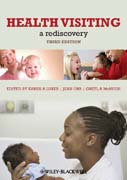
This timely and relevant new edition of an established and well regarded textis essential reading for those training to become health visitors and those who are practitioners working with and in the community. As we celebrate the 150 year anniversary of the profession in 2012, Health Visiting: A Rediscovery has been thoroughly revised and updated since the last edition to reflect the many developments in health policy, public health priorities and health visiting practice. The focus of the book, however, remains the same: placing the health visitor at the forefront of supporting and working with children and families, ensuring the child has the best possible start in life. The increasing importance of working with communities and reaffirming the public health role of the health visitor are discussed and debated. The new edition takes into account the challenges and increasing need for health visitors to engage with research evidence and to evaluate their practice. Key features: A definitive, comprehensive, updated textbook on the role of the Health Visitor Incorporates the practice of public health and working with communities Includes brand new chapter on the importance of safeguarding children and the enhanced child protection role of the Health Visitor Timely and topical Essential reading for all nurses working in the community, those training as Specialist Community Public Health Nurses and undergraduate students undertaking public health, primary and community care course units. Features case studies and learning activities INDICE: List of Contributors Introduction 1 Managing Knowledge in Health Visiting Kate Robinson Introduction Defining health visiting practice What do health visitors do and where do they do it? Evidence-based medicine The currentlandscape of evidence-based practice Refuting evidence-based practice So doesit work and if not, why not? Redefining evidence-based practice Managing knowledge and evidence in practice Case study 1.1: National policy-making in relation to inequalities in health Case study 1.2: Introducing new technology Case study 1.3: Creating guidelines in primary care Case study 1.4: Protocol-based decision-making in nursing Case study 1.5: Knowledge management in primary care Lessons from the case studies Communities of practice Reflective practice Clients: what do they know and how did they know it? Social networking sites Thedebate Summary References Appendix 1 Activities for Chapter 1 2 Health Visiting: Context and Public Health Practice Martin Smith and Maria Horne Introduction Public health Defining public Defining health Defining public health Human rights and public health The principles of health visiting The search for health needs The stimulation of an awareness of health needs The influence on policies affecting health The facilitation of health enhancing activities Health inequalities Summary References Appendix 2 Activities for Chapter 2 3 The Community Dimension Rosamund Bryar and Jean Orr Introduction Defining community Impact of communities on health The role of health visitors with communities Gaining an understanding of the health of your local community Windshield survey Public health walk Health needs assessment Using health promotion models to support community working Summary References Appendix 3 Activities for Chapter 3 4 Approaches to Supporting Families Karen I. Chalmers Introduction Models of intervention in family life Three models relevant to health visiting practice in families with young children Application of models in practice Policies Evidence for interventions to support families Characteristics of programmes to support families with young children Early home visiting programmes Current homevisiting programmes Family Nurse Partnership Programme Flying Start Wales Starting Well Scotland The Triple P Programme Positive Parenting Programme Sure Start Programmes Working with families Empirical evidence on relationship development Challenges Public health agenda Level of evidence Adhering to the programme criteria High needs families Practice specialisation Concerns about childsafety Adequate resources Summary References Appendix 4 Activities for Chapter 4 5 Safeguarding Children: Debates and Dilemmas for Health Visitors JulianneHarlow and Martin Smith Introduction The key concepts Defining child Definingchildhood Defining safeguarding Defining child abuse Defining significant harm Incidence and prevalence of child abuse Assessment of vulnerable children The Framework for the Assessment of Children in
- ISBN: 978-1-4443-3581-1
- Editorial: Wiley-Blackwell
- Encuadernacion: Rústica
- Páginas: 296
- Fecha Publicación: 20/01/2012
- Nº Volúmenes: 1
- Idioma: Inglés
